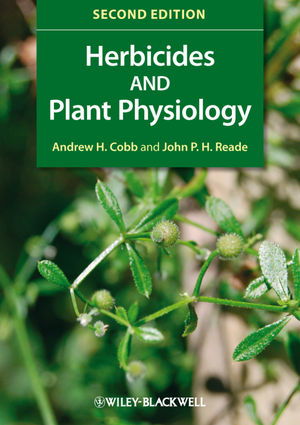Herbicides and Plant Physiology, 2nd EditionISBN: 978-1-4051-2935-0
Paperback
298 pages
October 2010, Wiley-Blackwell
 This is a Print-on-Demand title. It will be printed specifically to fill your order. Please allow an additional 15-20 days delivery time. The book is not returnable.
|
||||||
1 An Introduction to Weed Biology.
1.1 Introduction.
1.2 Distribution.
1.3 The importance of weeds.
1.4 Problems caused by weeds.
1.5 Biology of weeds.
1.6 A few examples of problem weeds.
1.7 Positive attributes of weeds.
1.8 The ever-changing weed spectrum.
1.9 Weed control.
References.
2 Herbicide Discovery and Development.
2.1 Introduction.
2.2 Markets.
2.3 Prospects.
2.4 Environmental impact and relative toxicology.
2.5 The search for novel active ingredients.
2.6 The search for novel target sites.
2.7 Mode of action studies.
2.8 A lower limit for rates of herbicide application?
References.
3 Herbicide Uptake and Movement.
3.1 Introduction.
3.2 The cuticle as a barrier to foliar uptake.
3.3 Physicochemical aspects of foliar uptake.
3.4 Herbicide formulation.
3.5 Uptake by roots from soil.
3.6 Herbicide translocation from roots to shoots.
3.7 A case study: the formulation of acids.
3.8 Recent developments.
References.
4 Herbicide Selectivity and Metabolism.
4.1 Introduction.
4.2 General principles.
4.3 Herbicide safeners and synergists.
References.
5 Herbicides That Inhibit Photosynthesis.
5.1 Introduction.
5.2 Photosystems.
5.3 Inhibition at Photosystem II.
5.4 Photodamage and repair of Photosystem II.
5.5 Structures and uses of Photosystem II inhibitors.
5.6 Interference with electron flow at Photosystem I.
5.7 RuBisCo activase.
5.8 How treated plants die.
References.
6 Inhibitors of Pigment Biosynthesis.
6.2 Inhibition of chlorophyll biosynthesis.
6.3 Inhibition of carotenoid biosynthesis.
6.4 Inhibition of plastoquinone biosynthesis.
6.5 How treated plants die.
6.6 Selectivity and metabolism.
References.
7 Auxin-Type Herbicides.
7.1 Introduction.
7.2 Structures and uses of auxin-type herbicides.
7.3 Auxin, a natural plant growth regulator.
7.4 Auxin receptors, gene expression and herbicides.
7.5 Signal transduction.
7.6 Auxin transport.
7.7 An ‘auxin’ overdose.
7.8 How treated plants die.
7.9 Selectivity and metabolism.
References.
8 Inhibitors of Lipid Biosynthesis.
8.1 Introduction.
8.2 Structures and uses of graminicides.
8.3 Inhibition of lipid biosynthesis.
8.4 Anti-auxin activity of graminicides.
8.5 How treated plants die.
8.6 Selectivity.
References.
9 The Inhibition of Amino Acid Biosynthesis.
9.1 Introduction.
9.2 Overview of amino acid biosynthesis in plants.
9.3 Inhibition of glutamine synthase.
9.4 Inhibition of EPSP synthase.
9.5 Inhibition of acetolactate synthase.
9.6 Inhibition of histidine biosynthesis.
References.
10 The Disruption of Cell Division.
10.1 Introduction.
10.2 The cell cycle.
10.3 Control of the cell cycle.
10.4 Microtubule structure and function.
10.5 Herbicidal interference with microtubules.
10.6 Selectivity and metabolism.
References.
11 The Inhibition of Cellulose Biosynthesis.
11.1 Introduction.
11.2 Cellulose biosynthesis inhibitors.
11.3 Selectivity and metabolism.
References.
12 Herbicide Resistance.
12.1 Introduction.
12.2 Mechanisms of herbicide resistance.
12.3 How resistance occurs.
12.4 Chronology of herbicide resistance.
12.5 Herbicide resistance case study – black-grass (Alopecurus myosuroides Huds.)
12.6 The future development of herbicide resistance.
References.
13 Herbicide-Tolerant Crops.
13.1 Introduction.
13.2 History of genetically modified, herbicide-tolerant crops.
13.3 How genetically modified crops are produced.
13.4 Genetically engineered herbicide tolerance to glyphosate.
13.5 Genetically modified herbicide tolerance to glufosinate.
13.6 Genetically modified herbicide tolerance to bromoxynil.
13.7 Genetically modified herbicide tolerance to sulfonylureas.
13.8 Genetically modified herbicide tolerance to 2,4-D .
13.9 Genetically modified herbicide tolerance to fops and dims.
13.10 Genetically modified herbicide tolerance to phytoene desaturase.
13.11 Herbicide tolerance due to engineering of enhanced metabolism.
13.12 Herbicide tolerance through means other than genetic modification.
13.13 Genetically modified high-tolerance crops in practice: the UK Farm-Scale Evaluations, 2000–2.
13.14 Future developments.
References.
14 Further Targets For Herbicide Development.
14.1 Introduction.
14.2 Protein turnover.
14.3 Biological control of weeds.
14.4 Natural products as leads for new herbicides.
References.
Glossary.
Index.



